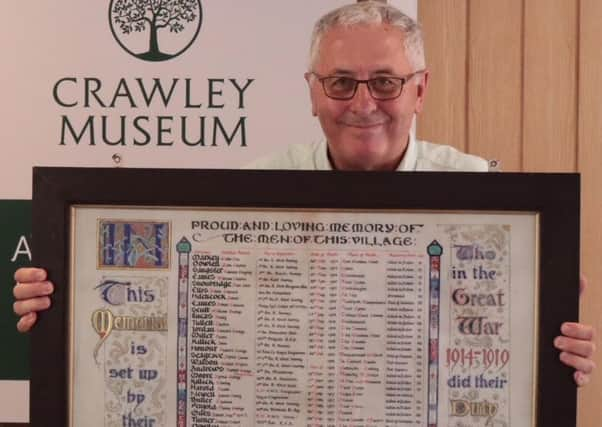Poignant scroll to go on display at Crawley Museum


Keen historian Geraint Thomas was determined to preserve a memorial roll of honour listing the names of people in Lowfield Heath who died in the First World War when he first came across it in the village church four years ago.
And this week with help from Crawley Museum curator Helen Poole the scroll was finally installed at the museum where it will form part of a Great War centenary exhibition.
Advertisement
Hide AdAdvertisement
Hide AdThe roll of honour had originally been housed at the Grade II listed St Michael and All Angels Church in Lowfield Heath - now the only original village building still standing after every other structure in the village was demolished to cope with the expansion of Gatwick Airport.
The last Anglican service was held at the church in 2004, but, as a Crawley borough councillor, Geraint was invited to a ceremony at the church four years ago. “I saw the scroll and just thought it deserved a wider audience,” he said.
“I had a sense of responsiblility that it deserved to be seen by people, particularly in view of the First World War centenary.”
He set about a three-year project on working to remove the scroll.
Advertisement
Hide AdAdvertisement
Hide Ad“Getting something moved from a church to somewhere else is a complicated process,” said Geraint.
But his work finally paid off on Wednesday when he was joined by Helen Poole and a representative from the Seventh-Day Adventists church - who now worship at St Michael and All Angels - to move the scroll to its new museum home.
Helen described the scroll as “absolutely beautiful” and said it would form part of a special display.
“We’re planning in November to commemorate the end of World War One and the Crawley people who came back and, much more frequently, those who didn’t come back.
Advertisement
Hide AdAdvertisement
Hide Ad“This scroll is perfect. It starts with the name of the first person to die in the war in 1914 and ends with the name of Frank Killick who died from sickness in 1919, three months after the war ended.
“It’s very sad and very poignant.”
Helen now plans to write to the diocese to see if she can find out more about the scroll and the names on it. “But,” she added, “it tells its own story.”